Mastering Rock Identification: A Comprehensive Guide


Intro
Identifying rocks can be a rewarding pursuit, whether you are just starting or have years of experience. Many individuals find themselves intrigued by the various types of rocks they encounter, spurring thousands of questions. What kind of rock is this? Where did it come from? How did it form? This guide is designed to empower you with the knowledge and tools necessary for effective rock identification.
Delving into this topic will not only enhance your skills but also help you appreciate the geological history intricately woven into each specimen. Understanding the science behind rocks, and their formation is essential for any hobbyist or collector.
You will discover key identification techniques, the importance of visual characteristics, and resources that can connect you with fellow enthusiasts. By following this guide, you can unveil the mysteries contained within your rock collections.
Preface to Rock Identification
Identifying rocks is a vital skill for anyone interested in geology, outdoor exploration, or collecting. Understanding the specifics of rock identification opens a window into the intricate story of Earth’s history. Rocks do not merely exist as random assemblages of minerals; they reflect environmental conditions, geological processes, and even past lifeforms. For enthusiasts, identifying rocks enhances appreciation for the natural world and encourages further exploration.
Importance of Identifying Rocks
Identifying rocks benefits both scientific inquiry and personal enrichment. For scientists, rocks serve as records of past climate, tectonic events, and biological activity. Each rock tells a unique story that can reveal significant historical data. For hobbyists and collectors, rock identification is not only about classification but also about connection. Collectors often develop emotional attachments to their specimens as they learn their backstories and source locations. Moreover, participating in rock identification fosters community bonding, allowing enthusiasts to share their knowledge and discover new insights together.
Rock identification also forms the foundation for practical applications, such as mineral exploration and land use planning. Knowing the types of rocks in an area can assist in decision-making processes regarding agriculture, construction, and conservation efforts. Understanding one’s environment enhances local stewardship, promoting conservation and responsible recreational practices.
Common Challenges in Identification
Despite the significance of rock identification, challenges can arise. One major hurdle is the sheer variety of rock types and their potential overlap. For instance, distinguishing between igneous and metamorphic rocks can be difficult. This complexity can lead to frustration, particularly for beginners.
Additionally, the observable characteristics of rocks can vary widely depending on environmental conditions and weathering processes. A rock's color may change when exposed to different lighting or moisture levels, making reliable identification tricky. Furthermore, some rocks may look similar but have vastly different geologies or compositions, obscuring a straightforward classification.
To mitigate these challenges, one must cultivate a systematic approach to rock identification. By learning essential characteristics and employing reliable identification techniques, individuals can improve their accuracy in naming rocks and understanding their context in the geological world.
"A systematic approach to rock identification can enhance not only accuracy but also understanding of geological processes."
Rock identification is essential for personal knowledge, scientific research, and increased environmental awareness. By acknowledging its importance and preparing for the challenges, anyone can appreciate the complexities of this fascinating field.
Basic Principles of Geology
The understanding of basic principles of geology is essential for anyone interested in identifying rocks. This knowledge lays the foundation for recognizing the various aspects of rocks and their classification. Fundamentally, geology encompasses the study of Earth's physical structure, the processes that shape it, and the materials that compose it. By grasping these principles, an individual can appreciate and analyze the characteristics of rocks typically found in nature.
One significant benefit of understanding these principles lies in improving identification skills. Knowledge of the rock cycle, especially, helps anyone discerning rock type and origin. Identifying where a rock comes from, how it was formed, and its composition allows deeper insight into its features and potential value. This understanding can also bridge the gap between amateur enthusiasts and more knowledgeable individuals in the field of geology.
Moreover, learning about geological processes encourages responsible collection practices. With awareness comes a sense of stewardship towards the environment. This responsibility involves not just collecting rocks but understanding their ecological context and adhering to local regulations affecting rock collection. Hence, being informed enhances both the experience and benefits of rock identification.
The Rock Cycle Explained
The rock cycle describes the dynamic transitions among the three primary rock types: igneous, sedimentary, and metamorphic. This process is continuous and influenced by external factors like weathering and tectonic activities. Understanding the rock cycle is crucial as it informs collectors about how rocks can change over time and provides insight into their current form.
For instance, igneous rocks form from cooled magma or lava. These rocks, through natural processes, can be eroded to create sediments, which can eventually compact to form sedimentary rocks. Similarly, sedimentary rocks, under high pressure and temperature, may metamorphose into metamorphic rocks. Knowledge of these transitions makes it easier to identify the characteristics of a particular rock sample in hand and understand its geological history.
Types of Rocks
Igneous Rocks
Igneous rocks are formed from the solidification of molten rock material. This key character makes them unique in their formation process. They can be classified into two main types: intrusive and extrusive. Intrusive igneous rocks, such as granite, solidify beneath the Earth's surface, allowing large crystals to form. Extrusive igneous rocks, like basalt, cool quickly on the surface, resulting in much smaller crystals.
Igneous rocks are a beneficial choice for collectors due to their extreme durability and beauty. Their often vibrant colors and varied textures offer a wide range of display possibilities. However, some igneous rocks may be more challenging to identify due to the similarities in appearance amongst various minerals.
Sedimentary Rocks
Sedimentary rocks are created from the accumulation of sediments over time. This type is important for identifying the history of Earth's surface and previous environments. A key characteristic of sedimentary rocks is their layered appearance, which results from the prolonged process of sediment compression. They often contain fossils, providing insight into past life on Earth.
For rock collectors, sedimentary rocks can serve as a window into geological history. Their variety often includes striking colors and textures, making them popular for display. However, they can be more susceptible to weathering, so careful handling is necessary to prevent damage.
Metamorphic Rocks
Metamorphic rocks arise from the alteration of existing rocks, whether igneous, sedimentary, or other metamorphic rocks, under heat and pressure. The unique characteristic of metamorphic rocks is their foliation, or layered texture, which is a result of mineral alignment during metamorphism. Common examples include schist and marble.
Collectors find metamorphic rocks significant as they often showcase striking patterns and colors. Their formation process provides insight into geological events, making them quite intriguing. However, their complex formation processes can make identification trickier, as many metamorphic rocks may resemble each other and even their parent rocks.
Understanding these basic principles enhances your rock identification journey while fostering a great appreciation for the Earth's treasures.
Fieldwork Essentials
Fieldwork is a crucial aspect of rock identification. It allows collectors to engage directly with their environment, ensuring a hands-on experience that facilitates a deeper understanding of geological formations. This section outlines the vital components needed for superb fieldwork in rock identification. Gathering the right tools and adhering to safety precautions are fundamental to ensuring a successful and enjoyable outing.
Gathering the Right Tools
Having the correct tools is essential for rock collecting. Each tool serves a specific purpose, enhancing the accuracy of identification and the overall experience in the field. Here are some recommended tools:
- Hammer: A geological hammer is ideal for breaking rocks. Look for one with a flat head for striking and a pointed end for prying.
- Chisel: Useful for precise splitting and detailed work on rock surfaces.
- Hand Lens: A magnifying glass will help you observe fine details in rocks and minerals, such as crystal structure and imperfections.
- Field Guide: A regional field guide can assist in identifying rock types and formation processes found in your specific area.
- Bag or Container: A sturdy bag or container is crucial for safely transporting your collected specimens.
- Notebook and Pencil: Documenting your findings can aid in future identification and appreciation of the context in which each rock was found.
Investing in these tools can significantly enhance the accuracy and enjoyment of any geological field trip.
Safety Precautions
Safety cannot be overstated when embarking on a rock collecting expedition. Prioritizing safety helps prevent injuries and ensures that the experience remains enjoyable. Consider the following precautions:
- Wear Appropriate Clothing: Sturdy boots, gloves, and long sleeves will protect against rough terrain and sharp rocks.
- Understand Your Environment: Familiarize yourself with the area. Weather patterns, wildlife, and terrain can affect safety.
- Carry a First Aid Kit: Essential for addressing minor injuries. It's better to be prepared in case of cuts or scrapes.
- Stay Hydrated: Bring enough water to avoid dehydration, especially in hot climates.
- Follow Local Regulations: Understanding legalities regarding rock collecting helps avoid fines and ensures respect for nature.
- Travel with a Buddy: Having someone else along can enhance safety, especially in remote locations.
Following safety precautions not only protects you but also encourages responsible rock collecting, which is vital for preserving natural habitats.
Implementing these fieldwork essentials can transform casual rock identification into a rewarding and safe experience. It sets the stage for successful exploration, deepening one's understanding of geology and rock formation.
Visual Identification Techniques
Visual identification techniques play a crucial role in rock identification. These methods allow collectors to employ their senses, particularly sight, to gather valuable information about a specimen. By observing color, texture, and other visual characteristics, individuals can often make initial classifications. This can be highly beneficial, as first impressions can guide the subsequent testing and analysis. Furthermore, understanding visual identification promotes a deeper engagement with the natural environment, fostering a connection between collectors and their finds.
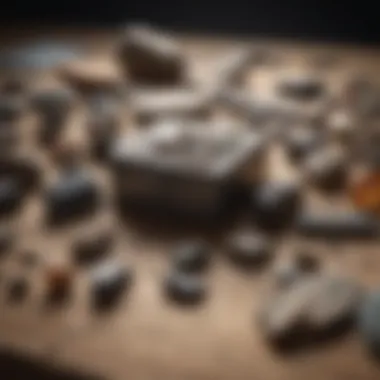
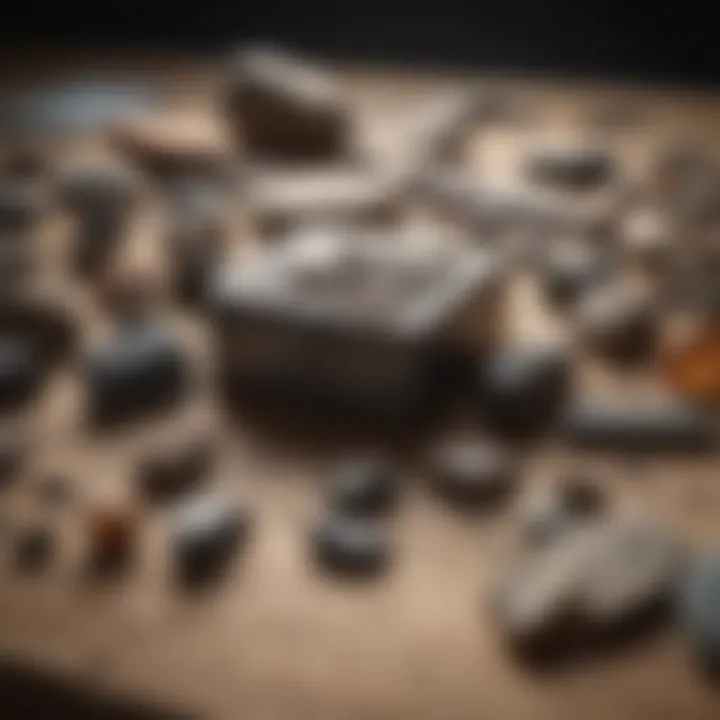
Assessing Color and Texture
Color and texture are among the first and simplest aspects to consider when identifying a rock. Color alone can provide insights into the minerals present. For instance, igneous rocks like basalt typically exhibit darker hues, while granite often appears lighter and speckled. However, relying solely on color can be misleading due to weathering or impurities. Therefore, texture should also be evaluated. The texture refers to the size, shape, and arrangement of minerals within the rock. For example, coarse-grained rocks have larger crystals, while fine-grained variants have smaller ones. The presence of visible layers, as in sedimentary rocks, also reveals information about the rock's history and formation.
"Understanding the interplay of color and texture can streamline your identification process and enhance your appreciation of geological diversity."
When assessing texture, consider these points:
- Grain Size: Notice the visibility of grains. Coarse grains are often easier to identify, while fine grains may require magnification.
- Surface Quality: Examine if the surface is smooth or rough. This can indicate the rock's formation process.
- Layering: Look for distinct layers which may suggest sedimentary origins.
Grain Size Analysis
Grain size analysis is another essential technique for rock identification. The size of mineral grains provides important contextual clues regarding the environment in which the rock formed. Rocks are generally categorized as having either coarse, medium, or fine grains.
Coarse-grained rocks, such as granite, indicate slow cooling of magma deep within the earth. In contrast, fine-grained rocks like basalt cool quickly on the earth's surface, preventing large crystal growth. Furthermore, examining variations in grain size within a rock, such as those seen in porphyry, can hint at the geological processes that have occurred.
To conduct a thorough grain size analysis, observe the following:
- Measure Grain Size: Use a ruler or micrometer for accuracy while noting sizes in millimeters.
- Identify Grain Shapes: Different shapes—angular or rounded—can indicate transport history or formation settings.
- Check Uniformity: A consistent grain size suggests a uniform formation process, whereas varied sizes may indicate a more tumultuous geological history.
By incorporating visual identification techniques like assessing color, texture, and conducting grain size analysis, anyone interested in rocks can enhance their identification skills significantly.
Using Physical Properties for Identification
Understanding the physical properties of rocks is crucial in the process of identification. These properties provide tangible metrics to assess and describe the rocks one encounters in various environments. By examining qualities such as hardness, streak, and luster, a more accurate identification can be made. This process not only enriches the collector's knowledge but also increases appreciation for the geological forms around us.
When identifying rocks based on physical properties, one should consider several factors. The accuracy of the identification relies heavily on the tools used, the technique employed, and the specific physical characteristics being evaluated. This not only aids in distinguishing between different types of rocks but also allows for a deeper understanding of their formation and the geological conditions under which they were created.
Hardness Testing
Hardness testing is among the most vital assessments when identifying rocks. The Mohs scale of mineral hardness ranges from 1 (talc) to 10 (diamond), offering a relative comparison of the ability of a mineral to resist scratches. Rock collectors can benefit by using simple methods to determine hardness, such as scraping the rock against a known material or using a set of mineral picks.
To perform a hardness test effectively, follow these steps:
- Gather Tools: Have your sample rock and a few materials with known hardness, such as a fingernail (about 2.5), copper penny (3.0), and glass (5.5).
- Perform the Scratch Test: Gently scratch the surface of the rock with each item. Note whether the rock scratches the item or vice versa.
- Evaluate Results: The hardest material that is unable to scratch the rock sets the upper limit of the hardness rating for that sample.
Hardness testing not only helps in classification but also unveils the history of a rock's formation through the pressure and temperature conditions it has endured.
Streak and Luster Evaluation
The evaluation of streak and luster complements hardness testing in rock identification. Streak refers to the color of the powder a mineral leaves when scratched across a porcelain plate. This test can differentiate minerals that may look similar but have different underlying compositions.
To assess streak effectively:
- Use a Streak Plate: A piece of unglazed porcelain can serve as an effective medium for testing.
- Make a Scratch: Gently rub the mineral or rock sample on the surface of the streak plate.
- Observe Color: Record the streak color. This can provide clues to the mineral content, often revealing more than the color of the rock itself.
Luster, on the other hand, describes how light reflects off the surface of the rock. It can be classified into various categories, such as metallic, glassy, or dull. Determining luster involves observing a fresh surface of the rock under direct light to understand how it interacts with light.
Chemical Properties in Rock Identification
Chemical properties play a crucial role in rock identification. They give insight into the composition and characteristics of rocks, which helps in their classification. Understanding these properties not only aids in identifying the rock type but also provides context regarding its formation and history.
The analysis of chemical properties can reveal specific elements present in a rock. For example, calcium carbonate in limestone can be identified by its reaction with acid. Knowing this can direct collectors to particular geological formations. Additionally, recognizing the mineral composition is fundamental in discerning a rock's origin.
Reactivity with Acid
One of the notable methods for rock identification is testing reactivity with acid, specifically hydrochloric acid. This test is often used to determine the presence of calcite, a key component in limestone and marble. When hydrochloric acid comes into contact with calcite, bubbles of carbon dioxide gas are produced, which indicates a positive reaction. This provides a quick and effective way to differentiate carbonate rocks from others.
Important considerations for this test include:
- Use diluted acid to prevent excessive reactions that can damage the rock.
- Always conduct the test in a controlled environment to ensure safety.
- Understand that not all rocks will react; this test is mainly for those containing carbonate minerals.
This technique is invaluable for field geologists and hobbyists alike, as it conservatively narrows down the possible types of rocks one might encounter in nature.
Mineral Composition Analysis
Analyzing mineral composition adds another layer of depth to rock identification. Each rock is made up of diverse minerals, and understanding these can lead to accurate categorizations. Techniques such as thin section microscopy or X-ray diffraction can be utilized to identify minerals at a granular level, providing detailed insights into the rock's make-up.
Key aspects of mineral composition include:
- Proportions of minerals: The percentage of different minerals can indicate whether a rock is igneous, sedimentary, or metamorphic.
- Color and streak: Specific minerals have unique colors or streaks that can help differentiate them from similar types.
- Crystal form: The shape of crystals can tell a lot about the cooling rate and environment of a rock's formation.
By combining results from acid tests with mineral composition analysis, rock enthusiasts can create a more comprehensive profile of a rock. This process enhances the educational value of rock collecting, transforming it from a mere hobby into a rigorous practice of scientific inquiry.
"Understanding chemical properties enriches the experience of rock identification and appreciation, offering both practical benefits and deeper geological insights."
Navigating these chemical characteristics requires attention to detail and a keen interest in the varied geological processes that shape our Earth.
Utilizing Technology in Identification
In the modern age, technology plays a crucial role in enhancing the process of rock identification. With the advent of mobile applications and digital resources, enthusiasts have access to tools that were once limited to trained professionals. These technological advancements allow hobbyists and researchers alike to identify rocks with increased accuracy and convenience. The integration of technology streamlines the identification process, enabling users to gather information quickly and efficiently.
One significant benefit is that many of these tools are user-friendly, catering to both beginners and experienced collectors. The immediacy of technological solutions fosters exploration and engagement, making the journey of rock identification less daunting. Moreover, as technology continues to evolve, the resources available for identifying rocks are expanding, offering more ways for individuals to learn.
Despite the advantages, it is important to approach technology with discernment. Not all applications or online resources are equally reliable. Users should consider the credibility of the information presented and cross-reference with reputable sources to ensure accuracy. By understanding both the strengths and limitations of technology, collectors can enhance their rock identification experiences.
Mobile Apps for Rock Identification
Mobile apps have emerged as significant tools for rock identification. Applications such as 'Rock Identifier' and 'Geology Toolkit' allow users to take photos of rocks and receive immediate feedback on potential classifications. This instant access to information democratizes geological knowledge, making it readily available to anyone with a smartphone.
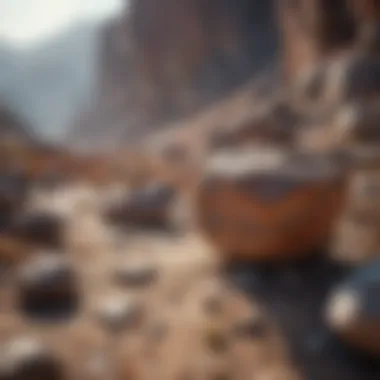

Key features to look for in mobile apps include:
- Photo Identification: Capture images of your rock to receive suggestions based on its characteristics.
- Database Access: Access a wealth of information about various rock types, minerals, and geological formations.
- Interactive Elements: Some apps offer quizzes or educational resources to enhance user understanding.
While these apps are convenient, users should validate the results. Cross-checking findings with established geological references, such as the Encyclopedia of Geology, will provide more comprehensive insight.
Digital Resources and Databases
The internet hosts a variety of databases and digital resources that are invaluable for rock identification. Websites like Wikipedia and Britannia feature extensive information on rock types, mineral properties, and geological processes. Reddit also offers community-driven discussions that can provide unique insights and experiences shared by fellow collectors.
For effective use, consider the following:
- Online Tutorials: Many platforms provide step-by-step videos that guide users through identification processes, covering important aspects like visual and physical property assessments.
- Research Articles: Access peer-reviewed research for in-depth understanding of the geological context behind identification methods.
Utilizing these digital resources not only substantiates your knowledge but also keeps you informed about the latest trends and discoveries in geology. Engaging with these platforms enhances both your computation and connection to the global rock-collecting community.
"Technology acts as a bridge, linking collectors to the vast world of geology and rock identification. It's a powerful tool that invites curiosity and exploration."
Consulting Experts and Communities
Understanding rocks and their properties can be a complex task. Therefore, consulting experts and communities familiar with geology is essential. Engaging with knowledgeable individuals can enhance your identification process significantly. Their insights often stem from years of experience and education, which can help you avoid common misidentifications and enrich your knowledge.
Local geologists are invaluable resources. Many universities or geological societies have experts who can assist you in identifying rocks. Finding a local geologist can lead to one-on-one discussions, field visits, or workshops. This direct interaction allows for a more personalized learning experience. You can ask specific questions and get tailored advice on the rocks you encounter. It could also lead to discovering new areas to explore based on their knowledge of local geology.
Consulting experts not only confirms identification but also fosters a deeper understanding of geological processes.
Moreover, communities and forums dedicated to geology offer tremendous value. Online platforms like Reddit and Facebook groups connect enthusiasts from various backgrounds. They provide an opportunity to share findings, seek help, and learn from others’ experiences. Participating in these communities allows you to gain diverse perspectives and approaches to rock identification. Here, you can post pictures of rocks you wish to identify, often receiving rapid feedback from seasoned collectors.
Thus, whether it is through local geologists or online communities, leveraging these resources can turn a simple rock identification into an educational experience, benefiting both novices and experts alike.
Documenting Your Discovery
Documenting your discovery is a vital aspect of rock identification. It goes beyond the basics of simply recognizing a rock type. Recording crucial details can greatly enhance your understanding and appreciation of your find. Accurate documentation allows you to keep track of where and how you found a rock, which can inform its geological context and significance.
Recording Location and Context
When you encounter a rock, the location where it was found plays a pivotal role in classification. Geology is largely influenced by its environment. Therefore, noting the specific location, such as GPS coordinates, nearby landmarks, or geological features, can provide essential insights into the rock's origins.
Understanding context involves assessing the surrounding materials—other rocks, soil types, and vegetation. This data paints a broader picture of the area's geology. For instance, if you discover a granite boulder in a region dominated by sedimentary layers, this could suggest historical geological activity such as volcanic activity or tectonic uplift. Recording factors such as the angle of the rock's strata, proximity to water bodies, or man-made structures also contributes to a comprehensive understanding.
Moreover, documenting your findings in a dedicated notebook or digital format creates a personal reference library. This effort not only enriches your knowledge but also aids in sharing your discoveries with others.
Photographic Evidence
Photographs are invaluable in the documentation process. Taking clear images allows you to capture the rock's details, which can be analyzed later. Good photographic practices include:
- Close-ups: Capture the rock's surface to highlight its texture and features.
- Contextual Shots: Take pictures that show where the rock lies within its environment. This provides clues about its formation and surroundings.
- Comparative Images: If possible, photograph the rock alongside similar specimens. This helps later when you compare and classify rocks based on their characteristics.
A well-documented series of photographs helps preserve your findings, even if you later give the rock away or lose it. It's essential to combine visual documentation with written notes for maximum effectiveness. Keep in mind that taking multiple photos from different angles will fairly represent your discovery.
Using both textual and visual records enriches your understanding and makes it easier to share findings with experts or communities interested in geology.
"Documenting your discovery is not just about identification; it builds knowledge and fosters curiosity about the natural world."
In summary, careful documentation of your rock discovery, including both location and photographic evidence, serves not only as a record for identification but also enhances the narrative of the rock's life and geological significance.
Beyond Identification: Understanding Geological Context
Rock identification is not merely an exercise in classification; it opens a window into the intricate processes that shape our planet. Understanding the geological context of your discoveries enhances the value of your rock collection and connects you to the Earth’s narrative. The geological context provides insights into the time scale, formation processes, and environmental conditions that produced the rocks. This understanding fosters a deeper appreciation for geology as a science and enriches the experience of collecting.
Exploration goes beyond identifying rock types; it involves comprehending their origins and implications. The benefits of understanding geological processes are numerous. It enhances critical thinking skills, encourages curiosity, and promotes environmental awareness. Furthermore, recognizing the significance of rocks in Earth’s history situates your collection within larger geological frameworks.
The Formation Processes of Rocks
The formation of rocks is a multifaceted process that occurs over vast time scales. Each rock type—igneous, sedimentary, and metamorphic—has its unique formation process.
- Igneous Rocks: Formed from cooled and solidified magma or lava, igneous rocks provide insights into volcanic activity. The cooling rate of the magma influences the resulting texture. Slow cooling results in coarse-grained rocks like granite, while rapid cooling leads to fine-grained rocks such as basalt.
- Sedimentary Rocks: These rocks form through the accumulation of sediments over time. They reveal much about the environment in which they were deposited. Weathering, erosion, and transportation of materials contribute significantly to this process. Fossils found in sedimentary rocks provide clues to past life and environmental conditions.
- Metamorphic Rocks: Created from existing rocks under heat and pressure, metamorphic rocks showcase the dynamic processes occurring within the Earth. Common examples include schist and gneiss. Understanding these processes can provide insights into tectonic movements and the transformation of materials.
By studying the formation processes of rocks, collectors gain context for each specimen. The story behind a rock enriches its significance and connects it to geological history.
Historical Significance of Geological Findings
The study of geological findings offers significant historical insights that can influence our understanding of the Earth’s past. Many geological discoveries have transformed our perspectives on natural events and their impacts. These findings help us understand the evolution of life and the Earth’s ecosystems.
Consider the following aspects of geological significance:
- Paleoenvironments: Rocks can tell stories about ancient climates and ecosystems. They help reconstruct the Earth's history and reveal information about conditions that prevailed millions of years ago.
- Tectonic Activity: Geological evidence can inform us about past tectonic movements, contributing to our understanding of earthquakes and continental drift. Studying rocks from various locations can trace the movement of tectonic plates over time.
- Natural Resources: Many resources, such as coal, oil, and minerals, are products of geological processes. Insights gathered from geological findings play a crucial role in finding and managing these resources sustainably.
"Understanding the historical significance of geological findings is crucial for both scientific inquiry and practical applications in resource management."
Preserving and Caring for Rocks
Caring for your rocks is crucial for maintaining their integrity and aesthetic appeal. Collectors often invest time, money, and passion into building their collections. Therefore, proper preservation techniques ensure that the beauty and information held within each specimen remain intact.
Ensuring your rocks are stored and maintained correctly can prevent deterioration caused by environmental factors, mishandling, or neglect. Understanding these factors is essential for any collector who wishes to foster a deeper connection to their specimens.
Proper Storage Techniques
Storing your rock collection properly is vital to avoid damage. Here are several effective methods:
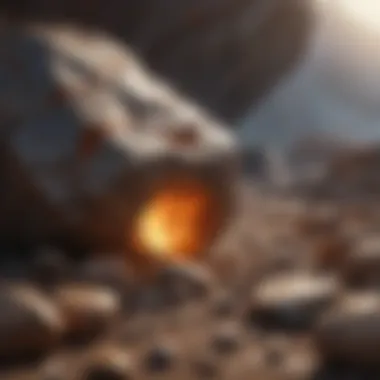
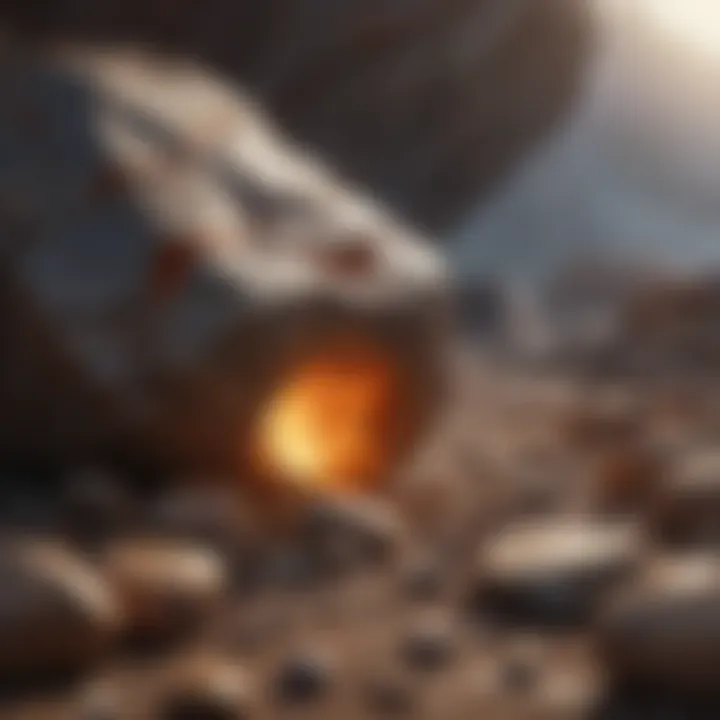
- Temperature Control: Avoid extreme temperature changes, which can cause cracking or splitting. A stable, moderate temperature is ideal.
- Humidity Management: Excess moisture can lead to mold or degradation. Using silica gel packets can help absorb moisture in storage areas.
- Containers: Use non-abrasive materials like plastic bags or acid-free boxes to hold your rocks. Ensure the containers keep out dust and contaminants.
- Labeling: Clearly label each container with the rock’s type and origin. It makes identification easier and promotes organization.
"Proper storage is essential to maintain the uniqueness of each specimen and protect it from environmental factors."
Cleaning and Maintenance Practices
Routine cleaning of your rocks can enhance their appearance and prevent any build-up of dirt or residue. Here are some recommended practices:
- Gentle Cleaning: Use a soft brush or cloth to remove dust. Avoid using chemicals unless necessary, as they can harm the rock.
- Water Rinse: For stones that can handle moisture, a gentle rinse with lukewarm water can help remove grime.
- Avoid Harsh Chemicals: Many cleaners can cause damage to the rock's surface. Stick to natural cleaning methods whenever possible.
- Regular Inspections: Periodically inspect your collection for any signs of wear, damage, or deterioration. Addressing these early can prevent more significant issues later on.
By following these techniques, collectors can ensure their rocks remain beautiful and informative pieces of the natural world for years to come.
Collecting: From Hobby to Passion
Collecting rocks can be a rewarding journey that transcends mere hobbyism. As individuals delve deeper into this practice, they often discover a profound passion for geology and the history embedded within each specimen. The importance of this topic lies in its ability to inspire enthusiasts to appreciate the natural world through its geological features. Engaging in rock collecting promotes a better understanding of earth sciences, encourages conservation efforts, and fosters connections within a community of like-minded individuals.
Building a Personal Collection
Creating a personal rock collection is an enriching process that allows collectors to capture aspects of their geological interests. To start, one should focus on identifying the types of rocks that resonate most. Here are some guidelines to consider:
- Choose a Theme: Some collectors focus on specific types such as igneous, sedimentary, or metamorphic rocks. Others might collect based on color, location, or mineral content.
- Documentation is Key: Record details about each specimen. This can include where it was found, its characteristics, and any relevant historical context. A dedicated journal can enhance appreciation for the collection.
- Storage Solutions: Invest in suitable storage options. Use display cases or cabinets that protect specimens from light and dust.
An example of an engaging collection could be a series of unique geodes, where each piece showcases the beauty of mineral formation in different locations.
Participating in Rock Shows and Expos
Rock shows and expos offer significant opportunities for collectors to expand their knowledge and enhance their collections. These events attract a wide range of enthusiasts, from amateurs to professionals, creating a unique platform for interaction. Here are some benefits of participation:
- Networking: Connecting with other collectors, vendors, and experts can lead to valuable exchanges of information, techniques, and even specimens.
- Educational Opportunities: Many shows host lectures and workshops. Attendees can learn about new collection methods, identification strategies, or the latest geological findings.
- Access to Unique Specimens: Numerous vendors sell rare rocks and minerals. Finding a distinctive piece can add depth to any collection and can even serve as a point of discussion among peers.
Participating in these events often sparks motivation and fosters enthusiasm for further exploration in the field of geology.
Ethical Considerations in Rock Collecting
Understanding ethical considerations in rock collecting is crucial for both newcomers and seasoned collectors. Collecting rocks is not just about personal enjoyment; it comes with responsibilities that impact the environment and the community. Ethical rock collecting encompasses legalities, respect for natural habitats, and the effects of personal actions on ecosystems.
Legalities of Rock Hoarding
When approaching rock collecting, it is essential to be aware of the legal issues that can arise. Not all rocks can be collected legally. Many regions have laws governing what can and cannot be taken from natural sites. These laws vary widely depending on location. In protected areas, such as national parks or reserves, removal of any natural material is usually prohibited. Collectors should also check local regulations regarding state and private lands.
It's important to always seek permission when on private property. Collectors who disregard these laws may face penalties, including hefty fines or even criminal charges. Besides the legal implications, respecting these laws reflects a commitment to responsible collecting practices.
Consider researching your local regulations before collecting. Understanding the laws can prevent potential legal troubles and promote ethical practices.
Respecting Natural Habitats
Respecting natural habitats is another fundamental element of ethical rock collecting. Rocks are part of broader ecosystems, serving as habitats for various organisms. Removal of rocks can disturb these ecosystems and lead to negative impacts on local biodiversity.
To practice respectful rock collecting, collectors should follow these guidelines:
- Collect Responsibly: Only collect in areas where it is permitted, and gather only what you need for your collection.
- Minimize Disturbance: Avoid sites that are particularly sensitive or fragile. Choose locations that can sustain some disturbances without significant ecological harm.
- Follow the Principle of Leave No Trace: When in nature, leave the environment as you found it. This means not rearranging rocks and ensuring that your activities do not leave permanent marks.
By adhering to these ethical considerations, rock collectors can enjoy their passion without causing harm to nature. Education and awareness about the local ecosystem enhance our collective responsibility toward the planet.
Ultimately, understanding the ethical implications of rock collecting can enrich the practice. This awareness leads to a more profound appreciation of geology and encourages others to respect natural environments.
Resources for Further Study
In the realm of geology, the importance of continuous learning cannot be overstated. Pursuing knowledge through diverse resources not only augments your understanding of rock identification but also deepens your appreciation for the geological sciences. Access to quality materials enhances the ability to recognize different rock types, comprehend their formations, and understand their historical significance. This section discusses various resources that can facilitate further exploration.
Books and Publications
Books remain a timeless resource for learning. They provide detailed insights that often blend scientific knowledge with beautiful illustrations. Some notable examples include:
- "The Rock Cycle" by John Wiley: This publication offers a foundational understanding of geological processes, ideal for both beginners and enthusiasts.
- "Petrology: Igneous, Sedimentary, and Metamorphic" by Daniel H. Rothman: A more advanced text, essential for those aiming to grasp the complexities of rock formation.
Furthermore, scientific journals often publish the latest research in geology. Subscribing to these journals, such as the Journal of Geological Sciences, can keep you informed of current trends and discoveries.
Websites and Online Courses
The digital era brings a wealth of information at your fingertips. Various websites cater to different aspects of rock identification and geology:
- Wikipedia: A vast reservoir of knowledge that provides comprehensive articles on the geology and specific rock types. Wikipedia
- Britannica: Offers well-researched articles and multimedia on geological processes and rock classification. Britannica
Online courses are also gaining popularity. Websites such as Coursera and edX offer courses specifically on geology and earth sciences. These courses provide structured learning pathways and often include expert-led lectures.
Engaging in forums, like those found on Reddit, can connect learners with experienced geologists and hobbyists. In these environments, discussions can lead to new insights and on-the-ground advice regarding rock collecting and identification.
"Resources for learning can transform your understanding of geology, making each discovery a meaningful experience."
Overall, diversifying your sources of information is beneficial. Books, websites, and courses can significantly enhance your rock identification skills.
Closure
The conclusion of this guide serves as a consolidation of the essential principles and practices involved in rock identification. Recognizing rocks is not merely about naming them; it is a gateway to understanding the Earth's history and the processes that shaped our planet. By grasping the fundamental concepts presented, individuals can effectively identify various rock types and appreciate their characteristics.
Recap of Key Points
During our exploration, we covered critical aspects of rock identification. Key highlights include:
- The significance of understanding the rock cycle, which sets the stage for rock transformations and classifications.
- A thorough examination of visual identification techniques, including color and grain size, which are vital tools for enthusiasts.
- The examination of physical and chemical properties like hardness and reactivity. These properties provide another layer of validation in identifying rocks.
- The use of technology, such as mobile apps, can greatly enhance the efficiency of identification processes, making it accessible to all.
- Collecting tips advise on ethical considerations, ensuring respect for geological formations and compliance with laws.
Encouragement for Continued Exploration
Continuing your journey in rock identification enriches not only your knowledge but also your connection with nature. Engage with local communities, take part in rock shows, and utilize resources that introduce you to broader geological concepts. The more you discover, the more nuanced your understanding becomes. Each rock has a story, and pursuing these stories contributes to a lifelong passion for geology.
"Every time you collect a rock, you're not just collecting a piece of nature; you're holding a fragment of Earth's history."
Remember, the world of rocks is vast. Embrace further study through books, documentaries, or online courses. Equip yourself with the information and tools you need. Each discovery can deepen your appreciation for the planet's complexity and beauty.



